Mobile phones are used extensively throughout the world. People need to be connected, but there are situations and places where their use is restricted due to security concerns and potential health risks. Research on mobile phone tracking has been going on for a long time. Many techniques have been developed or proposed on how to locate a mobile phone. Most of them try to find a way to use features such as the audio system, RF system, and general characteristics of the phone as a basis for locating the mobile phone. This project uses the RF system of a mobile phone as a detector to detect the presence of a mobile phone. A circuit is used to detect signals in the range of 0.9 GHz to 3 GHz. When a signal is detected, an LED flashes to indicate that a mobile phone is in use within a 1.5 meter radius.
Background
At present time in whole world mobile phones have become an very important and essential part of every people’s lives. Mobile phones are not only used for short messaging service (SMS), calls, email, and communication over the Internet, but advanced applications such as remote health monitoring systems and security systems are also integrated into mobile phones. In recent years, there has been rapid progress in value-added applications for mobile phones, such as high-resolution cameras and high-speed Internet connections. The country has also developed infrastructure to meet the growing need for fast internet connections. Safaricom has launched 4G internet infrastructure, which is now available in more than 13 cities across the country.
Despite the benefits that have come from these advancements in mobile technology, there are risks associated with their use. Corporate data mining has become a major threat in the industry as employees can access confidential company information and share it with competitors. This led to the development of cell phone jammers that completely block signal reception when entering company premises. The use of such devices violates privacy, but this does not eliminate the evil, as mobile phones can be linked to computers and information can be transferred and transmitted even when employees leave the company premises.
Inmates in correctional facilities use mobile phones inside the facilities to commit organized criminal activities or attempt to escape. The most common case in the country is when prisoners are defrauded by prisoners posing as organisers, who demand money as a fee from the winners to facilitate the award ceremony. Life support systems are also sensitive to mobile phone use. The use of cell phones in such facilities adversely affects the lives of individuals whose lives depend on the proper functioning of cell phones. Other places where cell phone use can damage sensitive equipment and become a nuisance include airplanes, gas stations, conference rooms, examination halls, and places of worship.
Therefore, it is true that there should be restrictions on the use of cell phones in some places. Because privacy laws prohibit the use of cell phone jamming devices, cell phone detectors must be designed and installed in such a way that anyone entering such locations with a phone is alerted and required to turn it off or exit. Be asked to take it. The effect of the cell phone detector is to continuously scan for the presence and use of cell phones and sound an alarm to notify the user or security personnel.
Problem Statement
A university has a policy banning the use of cell phones in the examination hall. When students enter the exam room, they are searched by the exam proctor. This search is gender-sensitive, and people feel that their privacy is being violated. It is unimaginable what would happen if there were no female staff to search female students, which is a common practice in engineering schools. This does not mean that only female students bring their mobile phones to the examination hall, but the content of these devices can be easily shared through messaging and Bluetooth, opening the door to serious cheating.
Justification Of The Problem
Even though the students were checked before entering the examination hall, some of them managed to take their mobile phones inside. Use of mobile phones in the examination hall can lead to cheating in the examination, as most mobile phones have high-resolution cameras and can read PDF documents, making class notes easily accessible during the examination. These can also be shared via Bluetooth, WiFi and messaging.
Since this problem has been present in universities for many years, there is a need to develop a system that can detect the presence and usage of mobile phones in the examination room. Therefore, the objective of this project is to develop a mobile phone detector that can be installed in examination rooms. Its purpose is to curb the evils because even if some people secretly bring mobile phones into the room, their usage and presence can be continuously monitored by the system and the culprits can be arrested.
This detector is not limited to use in examination rooms only; It can also be used in hospitals, conference rooms, correctional facilities, and other locations where mobile phone use is restricted.
Main Objective
The main objectives of this article are: (i). Design a circuit that can detect signals in the 0.9 GHz to 3 GHz range within a radius of 1.5 meters. (ii) Create a notification if a signal is detected in the 0.9 GHz to 3 GHz range.
Scope Of Work
The project is limited to detecting mobile phones in use, on demand, communicating through SMS services and accessing the Internet. Detecting mobile phones that are in standby mode, power off or airplane mode is beyond the scope of this project.
Read Also:
- History and Uses of Mobile Phones
- Development Of Mobile Industry
- Mobile Devices
- Role Of Ayurveda In The Management Of Mobile Phone Radiation Exposure
- Mobile Phone Radiations and Its Impact on Birds, Animals and Human Beings








Leave a Reply